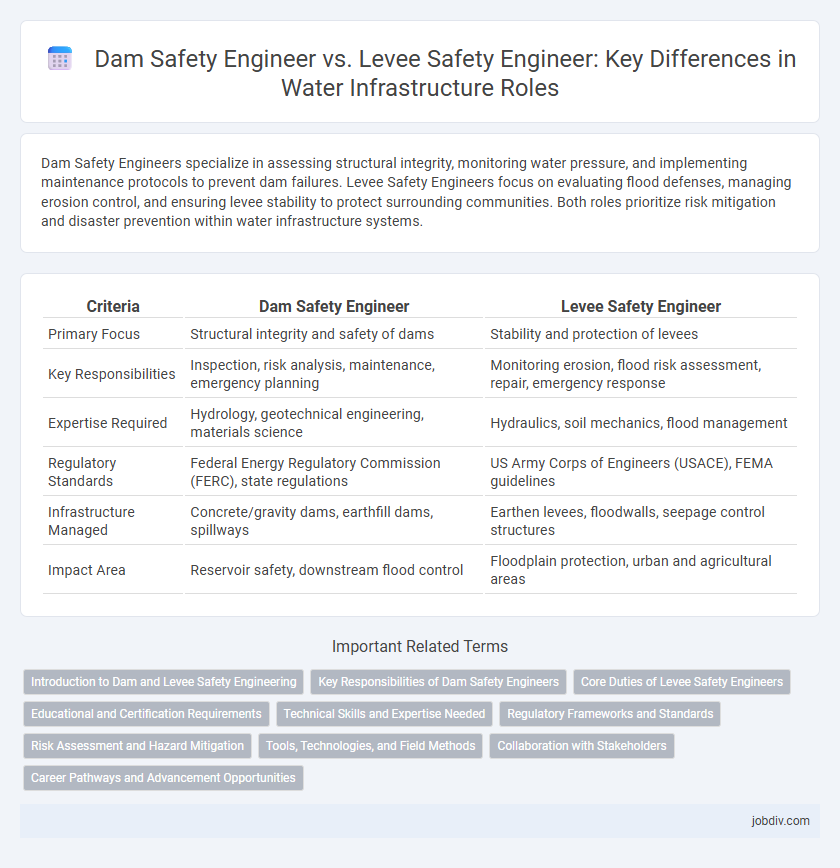Dam Safety Engineers specialize in assessing structural integrity, monitoring water pressure, and implementing maintenance protocols to prevent dam failures. Levee Safety Engineers focus on evaluating flood defenses, managing erosion control, and ensuring levee stability to protect surrounding communities. Both roles prioritize risk mitigation and disaster prevention within water infrastructure systems.
Table of Comparison
| Criteria | Dam Safety Engineer | Levee Safety Engineer |
|---|---|---|
| Primary Focus | Structural integrity and safety of dams | Stability and protection of levees |
| Key Responsibilities | Inspection, risk analysis, maintenance, emergency planning | Monitoring erosion, flood risk assessment, repair, emergency response |
| Expertise Required | Hydrology, geotechnical engineering, materials science | Hydraulics, soil mechanics, flood management |
| Regulatory Standards | Federal Energy Regulatory Commission (FERC), state regulations | US Army Corps of Engineers (USACE), FEMA guidelines |
| Infrastructure Managed | Concrete/gravity dams, earthfill dams, spillways | Earthen levees, floodwalls, seepage control structures |
| Impact Area | Reservoir safety, downstream flood control | Floodplain protection, urban and agricultural areas |
Introduction to Dam and Levee Safety Engineering
Dam Safety Engineers specialize in the structural integrity, hydrological assessments, and risk management of dams to prevent failures and ensure safe water retention. Levee Safety Engineers focus on the stability, erosion control, and flood risk mitigation of levees protecting floodplains and urban areas. Both disciplines prioritize continuous monitoring, maintenance protocols, and emergency preparedness to safeguard communities and infrastructure from water-related hazards.
Key Responsibilities of Dam Safety Engineers
Dam Safety Engineers primarily focus on assessing the structural integrity and operational safety of dams through regular inspections, risk analysis, and monitoring of hydrological and geotechnical data to prevent failures. They develop emergency action plans, oversee maintenance and rehabilitation projects, and ensure compliance with regulatory standards such as those established by the Federal Energy Regulatory Commission (FERC). Their expertise includes evaluating seepage, erosion, and foundation stability, using tools like finite element analysis and instrumentation data to safeguard downstream communities and water resources.
Core Duties of Levee Safety Engineers
Levee Safety Engineers specialize in assessing the structural integrity, flood risk management, and routine maintenance of levee systems to prevent breaches and ensure community protection. Their core duties include conducting geotechnical inspections, analyzing hydrologic data to predict stress on levees, and implementing emergency response strategies tailored to levee-specific vulnerabilities. These engineers collaborate closely with environmental scientists and local authorities to uphold safety standards and regulatory compliance for levee infrastructures.
Educational and Certification Requirements
Dam Safety Engineers typically require a bachelor's degree in civil or environmental engineering with specialized coursework in hydrology and structural analysis, often obtaining Professional Engineer (PE) licensure and certifications such as the Association of State Dam Safety Officials (ASDSO) Dam Safety Certificate. Levee Safety Engineers generally hold degrees in civil or geotechnical engineering and pursue certifications like the ASDSO Levee Safety Certificate, emphasizing soil mechanics and flood risk management. Both roles demand continuing education to stay current with federal regulations and advances in hydraulic modeling and risk assessment methodologies.
Technical Skills and Expertise Needed
Dam Safety Engineers require expertise in structural analysis, hydrology, and geotechnical engineering to assess dam integrity and manage flood risks effectively. Levee Safety Engineers specialize in soil mechanics, hydraulic modeling, and erosion control to design, inspect, and maintain levee systems that prevent river and coastal flooding. Both roles demand proficiency in risk assessment, emergency preparedness, and the use of advanced monitoring technologies to ensure resilient water infrastructure.
Regulatory Frameworks and Standards
Dam Safety Engineers adhere to regulatory frameworks such as the Federal Energy Regulatory Commission (FERC) guidelines and the National Dam Safety Program (NDSP), focusing on structural integrity, hazard classification, and emergency action planning. Levee Safety Engineers follow standards set by the U.S. Army Corps of Engineers (USACE) and the National Levee Safety Program (NLSP), emphasizing flood risk management, levee certification, and inspection protocols. Both roles require compliance with state-specific regulations and integration of risk assessment models to ensure public safety and infrastructure resilience.
Risk Assessment and Hazard Mitigation
Dam Safety Engineers specialize in assessing structural integrity and hydrologic risks to prevent catastrophic failures, utilizing advanced modeling to evaluate potential overtopping and seepage hazards. Levee Safety Engineers concentrate on analyzing soil stability and floodplain dynamics to mitigate breach risks, employing geotechnical investigations and flood risk mapping. Both roles prioritize risk assessment and hazard mitigation but apply distinct engineering principles tailored to the unique challenges of dams and levees.
Tools, Technologies, and Field Methods
Dam Safety Engineers employ advanced structural health monitoring systems, including piezometers, strain gauges, and remote sensing technologies like LiDAR and UAVs, to assess dam integrity and detect potential weaknesses. Levee Safety Engineers utilize geotechnical instruments such as inclinometers, settlement plates, and groundwater monitoring wells, combined with real-time data acquisition systems, to evaluate seepage, slope stability, and erosion risks. Both professionals incorporate GIS mapping, hydraulic modeling software like HEC-RAS, and drone inspections to enhance field data accuracy and improve risk management strategies.
Collaboration with Stakeholders
Dam Safety Engineers and Levee Safety Engineers collaboratively engage with diverse stakeholders to ensure structural integrity and flood risk management. They share critical data, enforce regulatory compliance, and coordinate emergency response plans with governmental agencies, local communities, and environmental organizations. Their joint efforts enhance resilience against water infrastructure failures and protect public safety.
Career Pathways and Advancement Opportunities
Dam Safety Engineers typically advance through roles involving structural analysis, risk assessment, and rehabilitation project management, gaining expertise in hydrology and geotechnical engineering essential for maintaining dam integrity. Levee Safety Engineers often build careers centered on flood risk mitigation, soil stability evaluation, and emergency response planning, specializing in hydraulic engineering and environmental impact studies relevant to levee systems. Both career pathways offer opportunities to progress into senior engineering positions, regulatory compliance roles, and consultancy, with certification opportunities such as Professional Engineer (PE) licensure enhancing advancement potential.
Dam Safety Engineer vs Levee Safety Engineer Infographic

 jobdiv.com
jobdiv.com